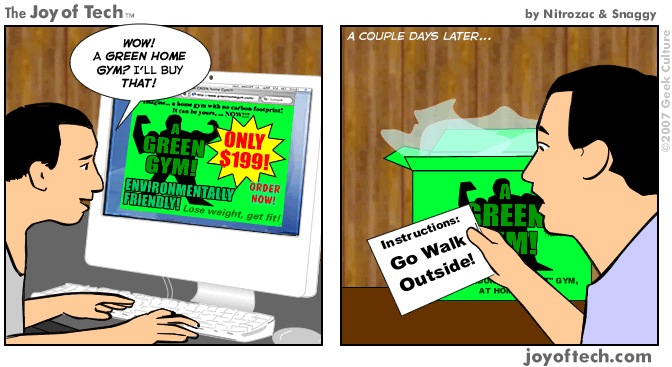This article gives some good tips on how to save energy while using a computer monitor and makes a good case for switching over to LCD monitors.
Do we need our monitor at it’s brightest all the time? Do we need Microsoft Word background look like white paper? Can we write white over black instead of black over white? Can we all follow some monitor manners and save energy?
By following simple monitor manners below, in fact we can save lot of energy.
1. When not in use, simply switch off the monitor by hand.
2. If fits in your budget, buy an LCD monitor.
3. Use “blank screen” as a screen saver option.
4. If your computer allows power setting control (all laptops usually do), then change power settings to “turn monitor off” after 2-5 minutes. These setting are usually accessible somewhere around screen saver settings.
5. Right click on your desktop or background, go to properties>appearance tab>advanced. Now select “window” in the list and select a light gray color instead of white. Play around with schemes, use your creativity.
6. Refer to the article
7. But be careful while printing because you are not printing what you see. At such times, you can easily revert back to default scheme from display settings.
8. Reduce brightness settings, increase contrast settings.
OK, So what’s the big deal?
If you look at statistics below, you will see that it can actually be a big deal.
The USA has almost 574 personal computers per thousand population, among the highest in the world. Barring a few exceptions, each personal computer has a monitor with it. So for 292 million population, @574 per 1000, we have 177 million monitors.
Just following one or two of the above tips above, you can easily reduce your monitor’s average consumption by around 20 W. If 177 million people save 15W per monitor, it accumulates to a gigantic figure of 3500 Mega Watts, or 3.5 GigaWatts.
If you saved 3.5 Gigawatts, you just shut down four coal fired power plants in Texas, namely Gibbons creek (1 X 480 MW), Welsh (3 X 558 MW), Sandow (3 X 121, 1 X 591 MW) and Oklaunion (1 X 720 MW). That means almost 5.25 million lb CO2 emissions avoided PER HOUR. Yes, I checked my calculations twice.
This savings can be realized on your CRT monitor, not a single penny out of your pocket. A perfect conservation. If you switch to LCD, you save a lot more.
And while the environmentalists within you are drooling over the idea of closing down coal fired power plants, do not forget these additional benefits.
* If you are not saving this energy, then what is happening to it? It is getting converted to bright light and is going in your eyes. Our eyes are not designed to stare at bright white thing from 2 feet close, 8 hrs a day, whole life. They deserve a break.
With my new monitor settings, I find my eyes much more comfortable at the end of the day.
* Amory Lovins (www.rmi.org) once said “Any attempt to make the car lighter by 1 lb actually ends up in making the car lighter by 1 and half lb”. Because when you reduce body weight, you can use lighter chassis, then you need lighter suspensions and so on. Similarly any attempts to reduce monitor consumption by 100 watts actually end up saving overall 110 watts (figuratively speaking). Because to show you something on monitor, computer processor has to do work, hard disks need to be spun, video card must be fired up and fan must run faster to cool these things down. When monitor is off, all these things can take it a bit easy by a watt here and a watts there.
* Just for fun I calculated how much money I would save if I saved 15 Watts for 6 hours every day. Turns out that @ 12 cents KWH rate, I would be saving around $4.85 per year. OK, you cannot buy Lexus with this saving. But hey, at the end of the day, where would you rather put extra 5$? In Your pocket or in your utility provider’s pocket?

